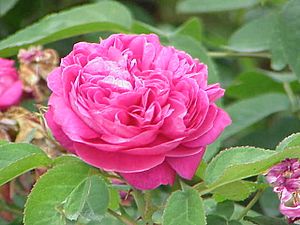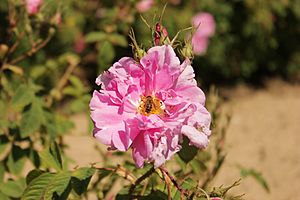Rosa × damascena facts for kids
Quick facts for kids Rosa × damascena |
|
|---|---|
 |
|
| Scientific classification | |
| Genus: |
Rosa
|
| Species: |
× damascena
|
The Rosa × damascena is often called the Damask rose. You might also hear it called the Bulgarian rose, Turkish rose, or Taif rose. It's a special type of rose that is a mix of two other roses: Rosa gallica and Rosa moschata. Scientists have also found that a third rose, Rosa fedtschenkoana, helped create the Damask rose.
These flowers are famous for their amazing smell. People grow them to make rose oil, which is used in perfumes. They also make rose water and other products from them. The petals of the Damask rose are even edible! You can use them to flavor food, as a decoration, in herbal tea, or preserved in sugar as gulkand.
Contents
What Does the Damask Rose Look Like?
The Damask rose is a deciduous shrub, which means it loses its leaves in the fall. It can grow up to 2.2 meters (about 7 feet) tall. Its stems have many strong, curved thorns and stiff bristles. The leaves have five (sometimes seven) smaller leaflets.
The roses are usually a light to medium pink or light red color. The flowers are quite small and grow in groups. The whole plant has a natural, informal shape. The Damask rose is an important type of Old Rose. It's also important because it's a parent to many other kinds of roses we see today.
Different Types of Damask Roses
There are two main types of Damask roses:
- Summer Damasks (R. × damascena nothovar. damascena) bloom for a short time, only during the summer.
- Autumn Damasks (R. × damascena nothovar. semperflorens (Duhamel) Rowley) bloom for a longer time, even into the autumn. They look very similar to the summer damasks.
Other famous roses like the Rosa × centifolia, Bourbon, Portland, and hybrid perpetual roses all have the Damask rose in their family tree.
'Celsiana' is a popular type of Damask rose with semi-double flowers.
The Story of the Damask Rose
The Damask rose doesn't grow wild in nature. It's a cultivated flower, meaning people have grown it for a long time. Recent genetic tests show it likely came from the mountains of central Asia or Iran. It's a mix of R. moschata, R. gallica, and Rosa fedtschenkoana.
Some stories say that a French Crusader named Robert de Brie brought the Damask rose to Europe from Syria. This happened around 1148 during the Second Crusade. The rose is named after the city of Damascus in Syria, which was famous for its steel, fabrics, and roses.
Other stories suggest that the ancient Romans brought it to their lands, including England. Another tale says that King Henry VIII received one around 1540 from his doctor.
People in Kabul Province of Afghanistan have a long history of making perfumes from the Damask rose.
In Hawaii, the flower is called Lokelani. It is the official flower of the Island of Maui.
How Damask Roses Are Grown
Damask roses are best grown in rows like hedges. This helps protect their delicate flowers from strong winds and makes it easier to pick them. Harvesting the flowers is hard work done by hand. It usually happens for about 20 to 40 days each year, depending on the type of rose. The picked roses are then taken to a central place to be turned into oil using steam.
Iran, Bulgaria, and Turkey are the biggest producers of rose oil from Damask roses. France and India also make a lot of rose oil for the world market. Other countries like Morocco and Tunisia used to produce it, but not much anymore. Afghanistan and Chile are also smaller producers.
In Bulgaria, the towns of Kazanlak and Karlovo have grown roses for thousands of years. This area is called the "Valley of Roses." The oil made from these roses is known as "Bulgarian Rose Oil" or "Bulgarian Rose Otto."
Turkish rose oil is sold as "Rose Oil" or "Turkish Rose Otto." In Turkey, families still have small distilleries, but the main production of high-quality rose oil is managed by a state group in the Isparta region. Small family farms grow the flowers, but they bring them to special places run by the group for distillation and quality checks.
India has also developed a big rose oil industry. They produce "Rose Attar" and "Rose Absolutes." Because labor costs are lower in India, their rose products are often less expensive than those from Bulgaria and Turkey.
Yummy Uses for Damask Roses
Damask roses are used in cooking to add flavor, like a spice. They are an ingredient in a spice mix called ras el hanout. Rose water and powdered roses are popular in Middle Eastern and Indian cooking. Rose water is often sprinkled on meat dishes, and rose powder is added to sauces. Chicken with rose is a well-known dish in the Middle East.
Whole flowers or petals are also used in an herbal tea called zuhurat. But the most popular use is flavoring desserts! You can find rose flavor in ice cream, jam, Turkish delights, rice pudding, and yogurt.
For hundreds of years, the Damask rose has been a symbol of beauty and love. The wonderful smell of the rose has been captured in rose water using methods that started in ancient times in the Middle East and later in India.
Today, Western cooking doesn't use roses or rose water as much. However, it was a very popular ingredient in ancient times and stayed popular until the Renaissance. It was most often used in desserts, and it's still a flavor in traditional sweets like marzipan or turrón. It has even started to appear again in cooking shows in the twenty-first century!
See also
 In Spanish: Rosa de Damasco para niños
In Spanish: Rosa de Damasco para niños



